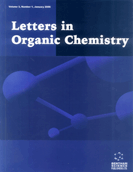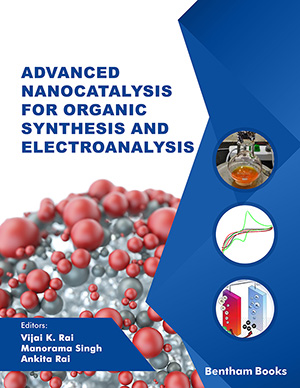Abstract
Heterocyclic are a class of compounds that are intricately entwined into life processes. Almost more than 90% of marketed drugs carry heterocycles. Synthetic chemistry, in turn, allocates a cornucopia of heterocycles. Among the heterocycles, indole, a bicyclic structure consisting of a six-membered benzene ring fused to a five-membered pyrrole ring with numerous pharmacophores that generate a library of various lead molecules. Due to its profound pharmacological profile, indole got wider attention around the globe to explore it fully in the interest of mankind. The current review covers recent advancements on indole in the design of various anti-cancer agents acting by targeting various enzymes or receptors, including (HDACs), sirtuins, PIM kinases, DNA topoisomerases, and σ receptors.
Keywords: Heterocycles, anti-cancer, cytotoxic activity, drug design, PIM kinases, DNA topoisomerases.
[http://dx.doi.org/10.1016/j.jmgm.2018.02.013] [PMID: 29609141]
[http://dx.doi.org/10.3390/molecules200916852] [PMID: 26389876]
[http://dx.doi.org/10.2174/1385272823666190717101741]
[http://dx.doi.org/10.1016/j.ejmech.2014.11.007] [PMID: 25466446]
[http://dx.doi.org/10.1002/med.20080] [PMID: 16788980]
[http://dx.doi.org/10.2174/138945010791170923] [PMID: 20298156]
[http://dx.doi.org/10.1016/j.bmc.2016.07.056] [PMID: 27499368]
[http://dx.doi.org/10.1016/j.jfluchem.2019.109353]
[http://dx.doi.org/10.1002/cbdv.201800470] [PMID: 30845369]
[http://dx.doi.org/10.2174/1385272821666171002121126]
[http://dx.doi.org/10.1016/j.jss.2016.04.021] [PMID: 27451867]
[http://dx.doi.org/10.1006/bbrc.1996.1631] [PMID: 8912651]
[http://dx.doi.org/10.2174/1385272822666181211122802]
[http://dx.doi.org/10.1207/s15327914nc4801_12] [PMID: 15203382]
[http://dx.doi.org/10.1158/0008-5472.CAN-06-4277] [PMID: 17409440]
[http://dx.doi.org/10.1158/0008-5472.CAN-09-0838] [PMID: 19531648]
[http://dx.doi.org/10.1038/sj.onc.1204365] [PMID: 11420705]
[http://dx.doi.org/10.1016/S0960-0760(01)00186-8] [PMID: 11897503]
[PMID: 11948137]
[http://dx.doi.org/10.1158/0008-5472.CAN-05-3918] [PMID: 16651453]
[http://dx.doi.org/10.1158/1535-7163.MCT-07-0476] [PMID: 18281517]
[http://dx.doi.org/10.1093/jn/133.7.2448S] [PMID: 12840223]
[http://dx.doi.org/10.1016/j.bcp.2009.05.008] [PMID: 19433067]
[http://dx.doi.org/10.1158/0008-5472.CAN-08-4423] [PMID: 19435906]
[http://dx.doi.org/10.1016/j.jss.2006.02.008] [PMID: 16580691]
[http://dx.doi.org/10.1177/1087057111422103] [PMID: 22086720]
[http://dx.doi.org/10.1530/JOE-11-0217] [PMID: 22159506]
[http://dx.doi.org/10.1016/j.ejmech.2018.02.065] [PMID: 29505935]
[http://dx.doi.org/10.4155/fmc-2017-0207] [PMID: 29642711]
[http://dx.doi.org/10.1016/j.bmcl.2012.12.089] [PMID: 23410798]
[http://dx.doi.org/10.1016/j.ejmech.2013.08.018] [PMID: 24013412]
[http://dx.doi.org/10.1016/j.bmcl.2015.05.015] [PMID: 26025875]
[http://dx.doi.org/10.1016/j.bioorg.2019.103281] [PMID: 31561106]
[http://dx.doi.org/10.1016/j.ejmech.2020.112561] [PMID: 32711231]
[http://dx.doi.org/10.1038/s41392-020-0109-y] [PMID: 32296034]
[http://dx.doi.org/10.1021/ml200259q] [PMID: 24900437]
[http://dx.doi.org/10.1016/j.bmcl.2011.08.105] [PMID: 21945284]
[http://dx.doi.org/10.1016/j.bmcl.2014.04.035] [PMID: 24775304]
[http://dx.doi.org/10.1016/j.bmcl.2018.05.054] [PMID: 29871845]
[http://dx.doi.org/10.1016/j.bmcl.2014.12.091] [PMID: 25616902]
[http://dx.doi.org/10.1016/j.bmcl.2014.12.067] [PMID: 25599837]
[http://dx.doi.org/10.1016/0165-6147(92)90030-A] [PMID: 1315463]
[http://dx.doi.org/10.1016/j.tips.2010.08.007] [PMID: 20869780]
[http://dx.doi.org/10.1016/j.cell.2007.08.036] [PMID: 17981125]
[http://dx.doi.org/10.1055/s-2004-832680] [PMID: 15547788]
[PMID: 15573866]
[http://dx.doi.org/10.1016/j.pharmthera.2009.07.001] [PMID: 19619582]
[http://dx.doi.org/10.1038/npp.2008.212] [PMID: 19052542]
[PMID: 7812973]
[http://dx.doi.org/10.2174/138161210793563365] [PMID: 21050178]
[http://dx.doi.org/10.1038/ncomms1386] [PMID: 21730960]
[PMID: 11816842]
[http://dx.doi.org/10.1016/j.bcp.2012.09.028] [PMID: 23058984]
[http://dx.doi.org/10.1038/cddis.2013.361] [PMID: 24091661]
[http://dx.doi.org/10.2174/138161212799436485] [PMID: 22288411]
[http://dx.doi.org/10.1039/C5MD00079C]
[http://dx.doi.org/10.1016/j.bmc.2013.11.033] [PMID: 24331758]
[http://dx.doi.org/10.1017/S0033583598003424] [PMID: 9794033]
[http://dx.doi.org/10.1038/nrm831] [PMID: 12042765]
[http://dx.doi.org/10.1146/annurev.bi.58.070189.002031] [PMID: 2549853]
[http://dx.doi.org/10.2165/00003495-199549010-00002] [PMID: 7705211]
[http://dx.doi.org/10.1016/S0022-2836(61)80004-1] [PMID: 13761054]
[http://dx.doi.org/10.1016/0022-2836(70)90429-8] [PMID: 5500444]
[http://dx.doi.org/10.1073/pnas.49.1.94] [PMID: 13929834]
[http://dx.doi.org/10.1016/j.chembiol.2010.04.012] [PMID: 20534341]
[http://dx.doi.org/10.1016/S0079-6603(00)64006-0]
[http://dx.doi.org/10.1016/0006-2952(88)90096-2] [PMID: 2847752]
[PMID: 7850785]
[http://dx.doi.org/10.1021/cb300648v] [PMID: 23259582]
[http://dx.doi.org/10.1038/nrc1977] [PMID: 16990856]
[http://dx.doi.org/10.1016/j.bmc.2008.02.036] [PMID: 18296054]
[http://dx.doi.org/10.1016/S0968-0896(01)00196-1] [PMID: 11597480]
[http://dx.doi.org/10.1021/jm00158a002] [PMID: 3525839]
[http://dx.doi.org/10.1016/0022-2836(89)90577-9] [PMID: 2738914]
[http://dx.doi.org/10.1021/jo062542q] [PMID: 17373847]
[http://dx.doi.org/10.1124/pr.56.2.6] [PMID: 15169927]
[http://dx.doi.org/10.1073/pnas.241509698] [PMID: 11724924]
[http://dx.doi.org/10.1021/bi00378a025] [PMID: 3567161]
[http://dx.doi.org/10.1039/b909153j] [PMID: 19707675]
[http://dx.doi.org/10.1016/j.bmc.2010.10.054] [PMID: 21094049]
[http://dx.doi.org/10.1021/np50111a020] [PMID: 7798965]
[http://dx.doi.org/10.1021/jm070040e] [PMID: 17602463]
[http://dx.doi.org/10.1016/S0040-4039(03)01046-3]
[http://dx.doi.org/10.1016/j.bmcl.2009.11.012] [PMID: 19945875]
[http://dx.doi.org/10.1016/j.ejmech.2010.02.001] [PMID: 20207053]
[http://dx.doi.org/10.1016/j.ejmech.2008.03.044] [PMID: 18504061]
[PMID: 7075859]
[PMID: 12042115]
[http://dx.doi.org/10.1016/S0960-894X(01)00136-6] [PMID: 11392530]
[http://dx.doi.org/10.1021/jm00194a018] [PMID: 490542]
[http://dx.doi.org/10.1021/jm049146p] [PMID: 15801827]
[http://dx.doi.org/10.1021/ci200220v] [PMID: 21932857]
[http://dx.doi.org/10.1021/jm301788a] [PMID: 23360284]
[http://dx.doi.org/10.1016/j.neo.2016.02.005] [PMID: 27108383]
[http://dx.doi.org/10.1038/sj.cr.7310149] [PMID: 17325692]
[http://dx.doi.org/10.1016/j.canlet.2008.08.016] [PMID: 18824292]
[http://dx.doi.org/10.1038/sj.onc.1210204] [PMID: 17322921]
[http://dx.doi.org/10.2119/molmed.2011.00020] [PMID: 21365126]
[http://dx.doi.org/10.1016/j.ejca.2013.05.009] [PMID: 23790467]
[PMID: 12939461]
[http://dx.doi.org/10.1158/1535-7163.MCT-09-0689] [PMID: 20197387]
[http://dx.doi.org/10.1021/jm2003552] [PMID: 21634430]
[http://dx.doi.org/10.1158/1078-0432.CCR-08-0376] [PMID: 18927309]
[http://dx.doi.org/10.1016/j.canlet.2009.02.019] [PMID: 19344997]
[http://dx.doi.org/10.1016/S0960-894X(03)00301-9] [PMID: 12749893]
[http://dx.doi.org/10.1016/j.bmcl.2009.03.101] [PMID: 19359173]
[http://dx.doi.org/10.1021/ml300366t] [PMID: 23493449]
[http://dx.doi.org/10.1021/jm401877m] [PMID: 24694055]
[http://dx.doi.org/10.1016/j.ejmech.2009.06.010] [PMID: 19608304]
[http://dx.doi.org/10.3109/14756366.2013.780237] [PMID: 23534931]
[http://dx.doi.org/10.1016/j.bmc.2015.08.040] [PMID: 26349626]
[http://dx.doi.org/10.1111/cbdd.12819] [PMID: 27416889]
[http://dx.doi.org/10.1021/jm0703136] [PMID: 17691763]
[http://dx.doi.org/10.1021/jm300197a] [PMID: 22439863]
[http://dx.doi.org/10.1016/j.ejmech.2014.08.020] [PMID: 25113875]
[http://dx.doi.org/10.1016/j.cclet.2015.03.015]
[http://dx.doi.org/10.1016/j.bmcl.2007.02.064] [PMID: 17346959]



























